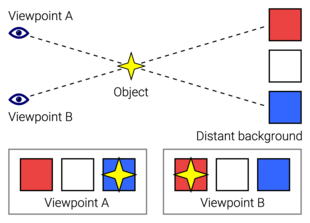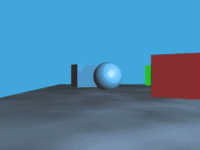
Back Parallaks Afrikaans اختلاف المنظر Arabic Paralax AST Parallaks Azerbaijani Паралакс Byelorussian Паралякса BE-X-OLD Паралакс Bulgarian Paralaks BJN লম্বন Bengali/Bangla Paral·laxi Catalan
This article needs additional citations for verification. (April 2020) |


Parallax is a displacement or difference in the apparent position of an object viewed along two different lines of sight and is measured by the angle or half-angle of inclination between those two lines.[1][2] Due to foreshortening, nearby objects show a larger parallax than farther objects, so parallax can be used to determine distances.
To measure large distances, such as the distance of a planet or a star from Earth, astronomers use the principle of parallax. Here, the term parallax is the semi-angle of inclination between two sight-lines to the star, as observed when Earth is on opposite sides of the Sun in its orbit.[a] These distances form the lowest rung of what is called "the cosmic distance ladder", the first in a succession of methods by which astronomers determine the distances to celestial objects, serving as a basis for other distance measurements in astronomy forming the higher rungs of the ladder.
Parallax also affects optical instruments such as rifle scopes, binoculars, microscopes, and twin-lens reflex cameras that view objects from slightly different angles. Many animals, along with humans, have two eyes with overlapping visual fields that use parallax to gain depth perception; this process is known as stereopsis. In computer vision the effect is used for computer stereo vision, and there is a device called a parallax rangefinder that uses it to find the range, and in some variations also altitude to a target.
A simple everyday example of parallax can be seen in the dashboards of motor vehicles that use a needle-style mechanical speedometer. When viewed from directly in front, the speed may show exactly 60, but when viewed from the passenger seat, the needle may appear to show a slightly different speed due to the angle of viewing combined with the displacement of the needle from the plane of the numerical dial.
- ^ "Parallax". Shorter Oxford English Dictionary. 1968.
Mutual inclination of two lines meeting in an angle
- ^ "Parallax". Oxford English Dictionary (Second ed.). 1989.
Astron. Apparent displacement, or difference in the apparent position, of an object, caused by an actual change (or difference) of the position of the point of observation; spec. the angular amount of such displacement or difference of position, being the angle contained between the two straight lines drawn to the object from the two different points of view and constituting a measure of the distance of the object.
Cite error: There are <ref group=lower-alpha> tags or {{efn}} templates on this page, but the references will not show without a {{reflist|group=lower-alpha}} template or {{notelist}} template (see the help page).